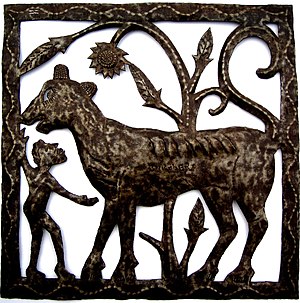The Tiger, the Brahmin and the Jackal

The Tiger, the Brahmin and the Jackal is a popular Indian folklore with a long history and many variants. The earliest record of the folklore was included in the Panchatantra, which dates the story between 200 BCE and 300 CE.
Mary Frere included a version in her 1868 collection of Indian folktales, Old Deccan Days,[1] the first collection of Indian folktales in English.[2] A version was also included in Joseph Jacobs' collection Indian Fairy Tales.[3]
Plot
A
Variants

There are more than a hundred versions of this tale [4] spread across the world. In some the released animal is a crocodile, in some a snake,[5] a tiger[6] and in others a wolf.
There are also modern illustrated versions of the tale, such as The Tiger, the Brahmin & the Jackal[9] illustrated by David Kennett and The Tiger and the Brahmin[10] illustrated by Kurt Vargo. Rabbit Ears Productions produced a video version of the last book, narrated by Ben Kingsley, with music by Ravi Shankar.[11] The variant by Rabbit Ears Productions alters certain bits of the story, where the Brahmin travels alone to gain the opinion of others. An elephant is included as first of the three things (the latter two being the tree and water buffalo) that the Brahmin encounters.
See also
Notes
- ^ Frere, Mary (1896). . – via Wikisource.
- ISBN 0-415-20476-3. p. 334.
- ISBN 1-60506-119-0. where it appears as The Tiger, the Brahman, and the Jackal. Jacobs gives his source as "Steel-Temple, Wideawake Stories, pp. 116-20; first published in Indian Antiquary, xii. p. 170 seq." It can be found online here at Google Books and here Archived 2011-07-11 at the Wayback Machine with its illustration.
- ^ Jacobs in his notes on the tale mentions that "No less than 94 parallels are given by Prof. K. Krohn in his elaborate discussion of this fable in his dissertation, Mann und Fuchs, (Helsingfors, 1891), pp. 38-60"
- ^ World Tales by Idries Shah has a version called The Serpent collected in Albania. The Farmer and the Viper is a more minimal Aesop's fable.
- .
- ^ Jacobs, Joseph. Europa's Fairy Book. New Tork and London: G. P. Putnam's Sons. 1916. p. 254.
- ISBN 0-86304-036-5.
- ISBN 1-86374-078-3.
- ISBN 0-88708-233-5.
- Rabbit Ears Productions media and release information.
